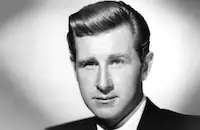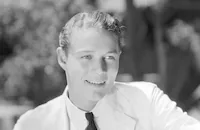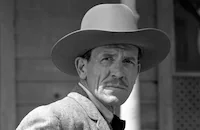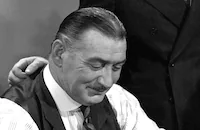Harmon of Michigan
Brief Synopsis
Cast & Crew
Charles Barton
Tom Harmon
Anita Louise
Forest Evashevski
Oscar O'shea
Warren Ashe
Film Details
Technical Specs

Synopsis
When Tom Harmon, the All-American quarterback from Michigan, graduates from college, he marries his sweetheart Peggy Adams and takes an assistant coaching job at a small college. Failing to get along with Jimmy Wayburn, the new head coach, Tom quits and moves to Chicago. Unable to find another coaching position because it is mid-season, Tom is forced to take a job with a second-rate professional team, earning five dollars per every minute he stays in the game. Although injured, Tom plays valiantly and is noticed by "Pop" Branch, the beloved head coach at Reserve College. Facing the challenge of beating Webster, their major competitor, Pop offers Tom the job of assistant coach in the upcoming season. At the start of the season, Reserve shows unexpected power in the opening games, prompting the Webster alumni to offer Tom a job as coach. Without consulting Peggy, Tom allows Bill Dorgan, an unscrupulous sports agent, to convince him to accept the new job, deeply wounding Pop. Tom's first task at Webster is to find plays that his heavy, poorly coached team can execute. He decides upon the flying wedge, a strategy outlawed because of its danger to players. Employing a variation of the wedge, Tom wins his first game, and although Freddy Davis, the team's quarterback, is injured, Tom devises more bone-crushing formations for the Webster boys. A few days before the big game, Pop implores Tom to stop using the wedge, but Tom ignores him. When Davis is injured again and carried off the field, Peggy, no longer able to tolerate her husband's insensitivity, decides to leave him. When his controversial plays are condemned by the other coaches as well as the Webster alumni, Tom, sobered by the turn of events, resigns and begins to drift around the country. Broke and despondent, he is on the verge of signing with a third-string team when he hears that Pop is taking over the coaching staff at a small Pacific Coast school. Immediately heading West, Tom offers to assist Pop, who warmly welcomes him back. When Peggy learns that her husband has signed with Pop, she hurries West to join them.

Director
Charles Barton
Cast
Tom Harmon

Anita Louise
Forest Evashevski
Oscar O'shea
Warren Ashe
Stanley Brown
Ken Christy
Tim Ryan
William Hall

Larry Parks

Lloyd Bridges

Chester Conklin

Bill Henry
Sam Balter
Wendell Niles
Tom Hanlon
Ken Niles
Harold Landon
David Durand
Tommy Seidel
Hal Cooke
Arthur Howard

Kenneth Macdonald
Nick Lukats
Edythe Elliott
Ben Taggart
Cy Ring

Dick Hogan
Franklin Parker

Edward Keane
Jack Carr
Jack O'malley
Crew
Fred Astholtz
Lionel Banks
Irving Briskin
Ridgeway Callow
Coach Jeff Cravath
Fredric Frank
Richard Goldstone
Howard J. Green
Wallace Macdonald
Stanley Rauh
Arthur Seid
M. W. Stoloff
John Stumar

Film Details
Technical Specs

Quotes
Trivia
Notes
The working title of this film was The Life of Tom Harmon. Harmon, who wore the number 98 jersey for the University of Michigan, scored 237 points in his three-year college career. Harmon's ability as a power runner made him one of the finest ball carriers of his time. After playing professional football for the Los Angeles Rams in 1946-47, Harmon became a sports commentator in Detroit, Michigan and then Southern California, and was appointed Sports Director of the Columbia Pacific Network. Harmon reported live on major sporting events for all the networks and was the voice of the Los Angeles Rams football games until his death in 1990. Harmon was married to actress Elysee Knox and was the father of actor Mark Harmon. At the film's opening, sports commentator Bill Henry describes Harmon's college career and shows newsreel footage of some of his plays. Radio commentators Ken Niles, Tom Hanlon, Wendell Niles and Sam Baller all portray themselves in the film. Forest Evashevski, who also plays himself, was Harmon's teammate at Michigan. This was the first of three films produced by Columbia based on the lives of college football stars. Other pictures in the series were Smith of Minnesota and The Spirit of Stanford (see below).












